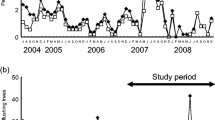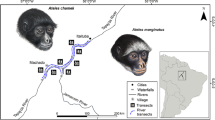Abstract
White-faced sakis (Pithecia pithecia) are Neotropical seed predators that ingest a mixed diet of fruit, leaves, and insects. We report timed feeding data for a 12-mo period on a group of 8 white-faced sakis occupying an island—a portion of their original home range—in Lago Guri, Venezuela. We collected fruit and leaf samples, dried them in the field, and analyzed them to measure nutrient content—free simple sugars (FSS), crude protein (CP), lipids, and total nonstructural carbohydrates (TNC)—and the presence of antifeedants: total tannins, condensed tannins and dietary fiber. We weighted nutrients and antifeedants by timed feeding samples to estimate actual intake. Then we compared intake among months and seasons. Compared with other frugivores, the average monthly intake of lipids was extremely high (16.1% by dry matter estimate(DM)), attributed to ingestion of young seeds and other plant parts that were relatively high in lipids, e.g., seed arils. Intake of FSS and CP were relatively low: 3.4% DM and 6.5% DM, respectively. The average intake of total cell wall or neutral detergent fiber (NDF = 38.4% DM) was only slightly lower than the range reported for colobines. Average intake of tannins was within the range reported for cercopithecines: condensed tannins of 3.3% Quebracho units standard (QU). We suggest that white-faced sakis accept a trade-off for food items that are fibrous or astringent if they are also rich in lipids. White-faced sakis expand the typical definition of primate fruit-eater in their high lipid-relatively high NDF-low FSS diet.
Similar content being viewed by others
Reference
Altmann, S. A. (1998). Foraging for Survival: Yearling Baboons in Africa, University of Chicago PressChicago, IL, 609pp.
Altmann, S. A., Post, D. G., and Klein, D. F. (1987). Nutrients and toxins of plants in Amboseli, Kenya. Afr. J. Ecol. 25: 279-293.
Alvarez, E., Balbás, L., Massa, I., and Pacheco, J. (1986). Aspectos ecológicos del Embalse Guri. Interciencia 11: 325-333.
Anapol, F., and Lee, S. (1994). Morphological adaptation to diet in platyrrhine primates. Am. J. Phys. Anth. 94: 239-262.
AOAC (1984). In Whilliams, S. (ed.), Official Methods of Analysis of the Association of Official Analytical Chemists. Association of Official Analytical Chemists, Arlington, VA.
Aymard, G., and Gouzález, V. (2003). A new species of Acosmium (Leguminosae: Papilionoideae, Sophovlae). Harvard Papers in Botany 7: 399-402.
Aymard, G., Norconk, M., and Kinzey, W. (1997). Composición florística de comunidades vegetales en islas en el Embalse de Guri, Rio Caroní, Estado Bolívar, Venezuela. BioLlania Edición Especiál. 6: 195-233.
Baranga, D. (1983). Changes in chemical composition of food parts in the diet of Colobus monkeys. Ecology 64: 668-673.
Bate-Smith, E. (1975). Phytochemistry of proanthocyanidins. Phytochemistry 14: 1107-1113.
Bell, E. A. (1978). Toxins in seeds. In Harborne, J. B. (ed.), Biochemical Aspects of Plant and Animal Coevolution, Academic Press, London, pp. 143-161.
Bremer, B., and Eriksson, O. (1992). Evolution of fruit characters and dispersal modes in the tropical family Rubiaceae. Biol. J. Linn. Soc. 47: 79-95.
Buchanan, D. B., Mittermeier, R. A., and van Roosmalen, M. G. M. (1981). The saki monkeys (genus Pithecia). In Coimbra-Filho, A. F., and Mittermeier, R. A. (eds.), Ecology and Behavior of Neotropical Primates, Vol. 1s, Academia Brasileira de Ciências, Rio de Janeiro, pp. 391-417.
Calvert, J. J. (1985). Food selection by western gorillas (G.g.gorilla) in relation to food chemistry. Oecologia 65: 236-246.
Conklin-Brittain, N. L., Wrangham, R. W., and Hunt, K. D. (1998). Dietary response of chimpanzees and cercopithecines to seasonal variation in fruit abundance. II. Macronutrients. Int. J. Primatol. 19: 971-998.
Conklin-Brittain, N. L., Dierenfeld, E. S., Wrangham, R. W., Norconk, M., and Silver, S. C. (1999). Chemical protein analysis: A comparison of Keldahl crude protein and total ninhydrin protein from wild, tropical vegetation. J. Chem. Ecol. 25: 2601-2622.
Davies, A. G., Bennett, E. L., and Waterman, P. G. (1988). Food selection by two south-east Asian colobine monkeys (Presbytis rubiunda and Presbytis melalophos) in relation to plant chemistry. Biol J. Linn. Soc. 34: 33-56.
Dubois, M., Gilles, K. A., Hamilton, J. K., Rebers, P. A., and Smith F. (1956). Colorimetric method for determination of sugar and related substances. Anal. Chem. 28: 350-356.
Fleagle, J. G. (1998). Primate Adaptation and Evolution, 2nd edn, Academic Press, New York, 596pp.
Gautier-Hion, A., Duplantier, J.-M., Quris, R., Feer, F., Sourd, C., Decoux, J.-P., Dubost, G., Emmons, L., Erard, C., Hecketweiler, P., Moungazi, A., Roussilhon, C., Thiollay, J.-M. (1985). Fruit characters as a basis of fruit choice and seed dispersal in a tropical forest vertebrate community. Oecologia (Berlin) 65: 324-337.
Gentry, A. H. (1993). A field guide to the families and genera of woody plants of Northwest South America (Colombia, Ecuador, Peru) with supplementary notes on herbacious taxa, The University of Chicago Press, 895pp.
Goering, H. K., and van Soest, P. J. (1970). Forage fiber analysis. Agricultural Handbook No. 379, Agricultural Research Service, U.S. Dept. of Agriculture.
Hagerman, A. E. (1987). Radial diffusion method of determining tannin in plant extracts. J. Chem. Ecol. 13: 437-449.
Hershkovitz, P. (1987). The taxonomy of South American sakis, genus Pithecia (Cebidae, Platyrrhini): A preliminary report and critical review with the description of a new species and a new subspecies. Am. J. Primatol. 12: 387-468.
Homburg, I. (1997). ökologie und sozialverhalten einer gruppe von weissgesicht-sakis (Pithecia pithecia pithecia Linnaeus 1766) im Estado Bolívar, Venezuela, Unpublished Dissertation, Universität Bielefeld, Germany.
Huber, O. (1986). La vegetación de la cuenca del Rio Caroní. Interciencia 11: 301-310.
Janson, C. (1983). Adaptation of fruit morphology to dispersal agents in a neotropical forest. Science 219: 187-189.
Jolly, A. (1985). The Evolution of Primate Behavior, 2nd edn, Macmillian Publishing Company, New York, 526pp.
Jordano, P. (1992). Fruits and frugivory. In Fenner, M. (ed.), Seeds: The Ecology of Regeneration in Plant Communities. C.A.B. International, pp. 105-155.
Kay, R. F. (1988). Diet. In Tattersall, I., Delson, I., and Van Couvering, J., Encyclopedia of Human Evolution and Prehistory. Garland Publishing, New York, pp. 155-179.
Kinzey, W. G., and Norconk, M. A. (1990). Hardness as a basis of fruit choice in two sympatric primates. Am. J. Phys. Anthropol. 81: 5-15.
Kinzey, W. G., and Norconk, M. A. (1993). Physical and chemical properties of fruit and seeds eaten by Pithecia and Chiropotes in Surinam and Venezuela. Int. J. Primatol. 14: 207-227.
Knott, C. D. (1999). Reproductive, Physiological and Behavioral Responses of Orangutans in Borneo to Fluctuations in Food Availability. PhD Thesis, Harvard University, Cambridge, MA.
Lambert, J. E. (1998). Primate digestion: Interactions among anatomy, physiology, and feeding ecology. Evol. Anthropol. 7: 8-20.
Lambert, J. E. (2002). Digestive retention times in forest guenons (Cercopithecus spp.) with reference to chimpanzees (Pan troglodytes). Int. J. Primatol. 23: 1169-1185.
Langer, P., and Chivers, D. J. (1994). Classification of foods for comparative analysis of the gastro-intestinal tract. In Chivers, D. J., and Langer, P. (eds), The Digestive System in Mammals, Cambridge University Press, pp. 74-86.
Lucas, P. W., Turner, I. M., Dominy, N. J., Yamashita, N. (2000). Mechanical defences to herbivory. Ann. Bot. 86: 913-920.
Maisels, F. (1993). Gut passage rate in guenons and mangabeys: another indicator of a flexible dietary niche? Folia Primatol. 61: 35-37.
McKey, D. (1974). Adaptive patterns in alkaloid physiology. Amer. Nat. 108: 305-320.
Milton, K. (1993). Diet and primate evolution. Sci. Amer. August, 1993: 86-93.
National Research Council (2003). Carbohydrates and fiber. In Committee on Animal Nutrition (eds.), Nutrient Requirements of Nonhuman Primates, 2nd rev. edn, National Academies Press, Washington D.C, Chap. 3, pp. 58-74.
Norconk, M. A. (1996). Seasonal variation in the diets of white-faced and bearded sakis (Pithecia pithecia and Chiropotes satanas) in Guri Lake, Venezuela. In Norconk, M. A., Rosenberger, A. L., and Garber, P.A. (eds.), Adaptive Radiations of Neotropical Primates, Plenum Press, New York, pp. 403-423.
Norconk, M. A., Conklin-Brittain, N. L. (2000). Methods for assessing nutrient intake in wild primates: temporal-vs. weight-based estimates. Am. J. Phys. Anthropol. Suppl. 32: 113-114.
Norconk, M. A., and Grafton, B. W. (2002). Changes in forest composition and potential feeding tree availability on a small land-bridge island in Lago Guri, Venezuela. In Marsh, L. M. (ed.), Primates in Fragments, Kluwer Academic/Plenum Publishers, New York.
Norconk, M. A., Grafton, B. W., and Conklin-Brittain, N. L. (1998). Seed dispersal by neotropical seed predators. Am. J. Primatol. 45: 103-126.
Norconk, M. A., Oftedal, O., Power, M., Jakubasz, M., and Savage, A. (2002). Digesta passage and fiber digestibility in captive white-faced sakis, Pithecia pithecia. Am. J. Primatol. 58: 23-34.
Norusšis, M. J. (1993). SPSS® for Windows™ Base System User's Guide, Release 6.0. SPSS, Inc. Chicago, 828pp.
Oates, J. F., Waterman, P. G., and Choo, G. M. (1980). Food selection by the south Indian leaf-monkey, Presbytis johnii, in relation to leaf chemistry. Oecologia 45: 45-56.
Parolin, P. (1992). Characterization and Classification of the Vegetation in an Island of Lake Guri, Venezulela. Unpublished MA Thesis, University of Bielefeld, Germany, March, 1992.
Pierce, W., and Haenisch, E. L. (1948). Quantitative Analysis, 3rd edn, John Wiley & Sons, New York.
Porter. L., Hrstich, L. M., and Chan, B. G. (1986). The conversion of procyanidins and prodelphinidins to cyanidin and delphinidin. Phytochemistry 25: 223-230.
Remis, M. J., Dierenfeld, E. S., Mowry, C. B., and Carroll, R. W. (2001). Nutritional aspects of western lowland gorilla (Gorilla gorilla gorilla) diet during seasons of fruit scarcity at Bai Hokou, Central African Republic. Int. J. Primatol. 22: 807-836.
Reynolds, V., Plumptre, A. J., Greenham, J., and Harborne, J. (1998). Condensed tannins and sugars in the diet of chimpanzees (Pan troglodytes schweinfurthii) in the Budongo Forest, Uganda. Oecologia 115: 331-336.
Rikimaru, T., Fujita, Y., Okuda, T., Kajiwara, N., Date, C., Heywood, P. F., Alpers, M. P., and Koishi, H. (1985). Utilization of urea nitrogen in Papua New Guinea highlanders. J. Nutr. Sci. Vitam. 31: 393-402.
Robertson, J., and Van Soest, P. J. (1980). The detergent system of analysis and its application to human foods. In James, W.P.T., Theander, O. (eds.) The Analysis of Dietary Fiber in Food, Marcel Dekker, New York, Chap. 8, pp. 123-158.
Strickland, J., Parsons, T. R. (1972). A Practical Handbook of Seawater Analysis, Bulletin 167, 2nd edn, Fisheries Research Board of Canada, Ottawa.
Strier, K. B. (2003). Primate Behavioral Ecology. 2nd edn, Allyn and Bacon, Boston, 422pp.
Tattersall, I, Delson, E., and Van Couvering, J. (1988). Encyclopedia of Human Evolution and Prehistory. Garland Publishing, New York.
Terborgh, J., Lopez, L., Tello J., Yu, D., and Bruni A. R. (1997). Transitory states in relaxing ecosystems of land bridge islands. In Laurance, W. F., and Bierregaard, R. O. (eds.), Tropical Forest Remnants: Ecology, Management, and Conservation of Fragmented Communities, Chicago University Press, Chicago, pp. 256-274.
van Roosmalen, M. G. M., Mittermeier, R. A., Fleagle, J. G. (1988). Diet of the northern bearded saki (Chiropotes satanas chiropotes): a neotropical seed predator. Am. J. Primatol. 14(1): 11-35.
Van Soest, P. (1994). Nutritional Ecology of the Ruminant, 2nd edn, Comstock Publishing Associates, Cornell University Press, Ithaca, NY.
Vié. J.-C., Richard-Hansen, C., Fournier-Chambrillon, C. (2001). Abundance, use of space, and activity patterns of white-faced sakis (Pithecia pithecia) in French Guiana. Am. J. Primatol. 55: 203-221.
Waterman, P. (1984). Food acquisition and processing as a function of plant chemistry. In Chivers, D. J., Wood, B. A., and Bilsborough, A. (eds.), Food Acquisition and Processing in Primates, Plenum, New York, pp. 177-211.
Waterman, P. G., and Kool, K. M. (1994). Colobine food selection and plant chemistry. In Davies, A. G., and Oates, J. F. (eds.), Colobine Monkeys: Their Ecology, Behaviour, and Evolution, Clarendon Press, Oxford, pp. 251-284.
Willson, M. F., and Whelan, C. J. (1990). The evolution of fruit color in fleshy-fruited plants. Am. Nat. 136: 790-809.
Author information
Authors and Affiliations
Corresponding author
Rights and permissions
About this article
Cite this article
Norconk, M.A., Conklin-Brittain, N.L. Variation on Frugivory: The Diet of Venezuelan White-Faced Sakis. International Journal of Primatology 25, 1–26 (2004). https://doi.org/10.1023/B:IJOP.0000014642.68751.ed
Issue Date:
DOI: https://doi.org/10.1023/B:IJOP.0000014642.68751.ed




